Toyota Corolla Cross Hybrid vs Kia Seltos Comparison

This comparison is a contest of philosophies.
In the red corner is the Toyota Corolla Cross Hybrid. Debuting just about a year ago, the electrified version of Toyota’s smallest SUV fixes one of our biggest gripes with the original model: it was capital-S Slow. Not only does the CCH pick up the pace, it offers significant savings at the pumps too—and who amongst the small-SUV set doesn’t love that?
In the blue corner is the Kia Seltos. The veteran of this pairing, it sees a significant facelift for this model year, ratcheting up the cabin tech while ditching the dual-clutch transmission for a smoother eight-speed automatic. The Seltos gives owners more toys, but it has one of the thirstiest turbo engines in the segment.
Managing editor Mike Schlee and I spent a week living with both. Which one was the better partner in the daily grind? Let’s see.
Interior and cargo space
Toyota Corolla Cross Hybrid: The CCH cabin is where this high-rider really leans on that Corolla heritage. This is a simple, basic layout with no muss or fuss. Toyota has grouped all the common-use controls in a small panel below the central touchscreen, and left the rest of the dashboard for one uninterrupted span of soft-touch. A pair of metallic stanchions zone off the wireless charger, about the closest thing to rugged the CCH cabin manages. The seat and wheel heat controls float just above this, looking only slightly like afterthoughts.
Front-seat comfort is high, with good lower back support and a welcome range of adjustments. Only the driver has power adjustment, however. Sight lines are generally good, as the Toyota’s rear quarter window is lower and less angled. The seat heaters get to work very quickly; useful during a blustery March shoot day.
The Corolla Cross bests its Korean competitor in just two interior measurements: front legroom (42.9 inches / 1,090 millimetersm against 41.4 in / 1,052 mm) and rear headroom (39.0 in / 991 mm beats 38.4 in / 980 mm). In every other way however, the Toyota is the smaller vehicle. You notice it in the narrow center console, which lacks the storage capacity of the Kia’s. Adults in the rear will definitely feel the pinch, with just 32.0 inches (813 mm) of legroom. Sitting back there it doesn’t feel like the massive six-inch gulf the on-paper stats suggest, but the Toyota is certainly tighter, especially at the hips.
The story is the same for cargo capacity, where the CCH offers 21.5 cubic feet (609 liters) of storage space. The shape is narrower, and there are more border protuberances to contend with. That being said, the Toyota nearly matches the Kia in the seats-down race, with 61.8 cubes (1,750 L).
Kia Seltos: The Kia cabin is a much busier, techier space than the prosaic Toyota. A new twin-screen setup dominates the dashboard and, just like the CCH, there is a welcome spread of physical buttons just below. There are a lot of textures and materials at play here: high marks to the fractal-like speaker covers and the premium-looking (and -feeling) perforated synthetic leather seats. The door panel plastics are a cheap touchpoint, however.
Kia buyers get to enjoy power adjustability for both front seats. In addition, this tester not only matches the Toyota’s heated seats and wheel, but throws in front ventilation for good measure. The Kia’s more rounded seats are mounted higher: they hug the lower torso but offer little shoulder support. The longer seat cushion should please the lankier amongst us.
Back seat space is an easy Kia win here. Not only is it more spacious, particularly in width and legroom, but the lighter headliner and forward-placed quarter window makes it an altogether more inviting space for adults. I personally have a slight preference for the Corolla Cross’ seats themselves, but I’m also rocking a 30” inseam.
Seats-up storage space is another Kia win at 26.6 cubic feet (753 L). It wins with ‘em down too, but only just: 62.8 cubes (1,778 L).
Bottom Line: Both Schlee and I preferred the Toyota’s driver’s seat. Factor in the rest of the cabin, however, and the Kia is the more inviting choice.
Toyota Corolla Cross Hybrid vs Kia Seltos: Tech and Features
Corolla Cross Hybrid: Toyota’s latest infotainment is a massive jump up from the last. It’s quick, modern, and happily accepts wireless Apple or Android mirroring. There are daily-use annoyances, however: the lack of physical buttons makes swapping between the native layout and CarPlay a multi-touch affair, for one. Toyota making navigation a subscription still leaves a sour taste, too.
For those who don’t just use their mobile music streaming app of choice, the Sirius XM screen can become a jumble on this 8.0-inch setup, and it’s needlessly tough to browse channels.
While it doesn’t boast the wow-factor of the Kia’s fully digital instrument cluster, the Toyota’s hybrid setup is super-easy to read and still offers plenty of selectable, relevant display info. The Corolla Cross skips any sort of head-up display. Both of these little cute-utes feature powered tailgates: it’s still a relative rarity in the segment.
Toyota Safety Sense 3.0 is an excellent suite of driver assists, with a simple-to-use full-range adaptive cruise control, lane-keep assist and road sign recognition. The Corolla stays in its lane with minimal ping-ponging, while leaving natural gaps between other vehicles. The rear cross-traffic alert in particular is very effective in supermarket parking scenarios.
Kia Seltos: The Seltos certainly has the edge in screen real estate. Its twin-screen setup is crisp and clear, with nice touches like a background that syncs with the time of day. The main infotainment menu is still the usual simple Kia setup, but navigating it using peripheral vision is tough because of the uniform color scheme and poor typeface. Props to Kia for the family-friendly Quiet Mode though.
Until the Seltos switches to Kia’s latest ccNC infotainment, you’ll want to bring a cord to pair your phone. Once you do, however, the extra width of the Kia screen makes it easy to use.
In addition to the afore-mentioned ventilated front seats, other features the Kia boasts include a head-up display and digital key. A welcome touch is a three-level automatic climate control system, though the trade-off is a single-zone setup. The Bose sound system is wholly passable, just like the JBL system in the Toyota.
Kia’s safety suite matches Toyota’s. While the adaptive cruise control has a touted navigation-based upgrade, in use, it is indistinguishable from the Toyota’s: they both do a good job keeping the car in the middle of its lane, with predictable acceleration and braking.
Bottom Line: As Kia has done for years now, it bundles in plenty of tech on top models, some of which is rare in the segment. The Kia has more toys, and continues its winning streak.
Powertrain, Driving Feel, and Efficiency
Corolla Cross Hybrid: The CCH is basically a Prius on stilts. It takes a modified version of the 2.0-liter engine and shacks that up with a pair of electric motors, one at each axle. It’s important to note there is no physical connection between front and rear, however: the Hybrid’s AWD is of the on-demand electric variety. An e-CVT delivers the power up front: 196 horsepower in total, pipping the Kia by one pony.
Torque is officially just 139 pound-feet, but that’s a misleading figure. In the real world, the instant-access twist from those electric motors ensures the CCH moves with authority. More than the new-found quickness, it’s the responsiveness that makes the Toyota such a great daily driver. On the flip side, when the system needs the ICE component, the 2.0-liter comes on-stream with a drone that you won’t find in the Kia. The four-pot settles down once on the highway, but a little more sound insulation would do the CCH wonders.
According to Toyota, the Hybrid XSE boasts a sportier (read: stiffer) suspension setup over the regular CC. It’s still a smoothie as far as we’re concerned though, with a well-damped, pliant ride in both city and highway settings. The steering is typical Toyota TNGA: super light but always accurate and consistent. Neither one of these models are the drivers’ choice in this segment, but the Corolla’s more eager turn-in and that hybrid torque makes it the more fun of the pair, should you find yourself in the mood.
Not only is the Corolla Cross the better drive, it is far better on fuel economy. The official combined figure is 42 mpg (5.6 L/100 km); during a cold week, we fell just shy of that at 40 mpg (5.9 L/100 km).
Seltos: The Seltos also comes with a naturally-aspirated 2.0-liter in base form. This model swaps in the familiar 1.6-liter turbo-four that’s in various Kia (and Hyundai) models. Both horsepower and torque sit at 195, which is on the higher end of the segment. For 2024, Kia has dropped the sometimes-jerky dual-clutch for a traditional eight-speed automatic transmission.
In most situations, this is an improvement over what came before. The Seltos is torquey, and the eight-speed has ideal ratios to make the most of that muscle in and around town. There are moments when it refuses to kick down however, where there’s a solid two-second delay after the go-pedal hits its stop. This is especially frustrating on short highway on-ramps where you need the power right away.
Whereas the Corolla Cross Hybrid has a crossover feel, the Seltos leans more traditional SUV. It’s a little stodgier, less eager to turn in but with more body roll once it does. As Schlee puts it, the whole vehicle just feels a little softened, like everything is being run through a filter or three. It’s likely fine for most buyers, but the Toyota feels no worse in day-to-day for its added responsiveness.
The Kia is also super thirsty. Officially it manages just 26 mpg (9.1 L/100 km) combined. Like the CCH, the Seltos couldn’t match the official figures during our cold-weather week, doing 24 mpg instead (9.8 L/100 km).
Bottom Line: The Toyota claws back big points here. Not only is it better to drive, it is over 40-percent more efficient. That’s a big advantage to ignore.
Toyota Corolla Cross Hybrid vs Kia Seltos: Styling
Corolla Cross Hybrid: There isn’t a whole lot particularly Corolla about the Corolla Cross. The headlights follow the same basic shape—thinner inside, larger outside—but are softer than the sedan’s angular units. The taillights sort of look like those of a Corolla, if you squint. It’s more shrunken-RAV4 than anything, after a date with a roll of sandpaper. The hybrid gains a unique front clip with a T-shaped grille insert, black-out trim, and more interesting wheel designs, seen here in 18-inch form. A handful of more interesting colors help the hybrid stand out, too.
Seltos: The Seltos’ shape makes it clear right away that this is the spacious choice. Tall and upright, it has short overhangs generous cladding, and raised roof racks—the latter bits coming by way of the X-Line trim. Like the Toyota, the Kia blacks out a bunch of trim, even including the 18-inch wheels. The facelift has made the rear more distinctive thanks to a full-width lighting element. It’s important to note that the LED headlights and foglights you see on this tester are Canadian-exclusive: in America, the X-Line sits below the SX, and sticks to projector-style units.
Bottom Line: As ever, your tastes may vary. The Seltos has a distinct SUV feel, while the Toyota feels better-suited to the city.
Pricing and Value
Corolla Cross Hybrid: As built, the CCH XSE rings up at $35,305 ($39,820 CAD) including destination. This includes $2,550 in options in the US; the only option in Canada is the contrast roof ($540 CAD). The top gas-only model, the XLE AWD, would cost $32,785 ($37,880 CAD).
Seltos: In America, the X-Line is the penultimate trim, costing $30,165 including destination. It misses out on advanced junction turning detection, nav-based cruise control, highway driving assist, digital key, power tailgate, and a few other convenience features found on this tester. That’s because the X-Line is the top trim in Canada, where it will set you back $41,394 CAD.
In America, an SX with all the goodies found here but minus the visual kit would cost $32,665.
Bottom Line: The value proposition depends on the side of the border. The Kia is noticeably more affordable in X-Line form in the US, but misses out on numerous goodies our tester has. Even still, an SX undercuts the CCH XSE by a few grand. In Canada, the Toyota is the more affordable choice.
Toyota Corolla Cross Hybrid vs Kia Seltos Comparison: Verdict
There’s a lot to recommend the Kia Seltos for. It has great showroom appeal, with plenty of kit and—in America—a more affordable price tag. It is also undoubtedly more spacious, so folks looking to cram as much as possible into a small footprint will find a lot to like here.
For us, the Corolla Cross Hybrid just beats the Kia. Its appeal is more than on-paper stats: in practice, its smoother drive and general ease of use make up for a tighter second row and less kit. Factor in that stellar fuel economy—something nothing else in this segment can really address—and it’s our winner.
Become an AutoGuide insider. Get the latest from the automotive world first by subscribing to our newsletter here.

Kyle began his automotive obsession before he even started school, courtesy of a remote control Porsche and various LEGO sets. He later studied advertising and graphic design at Humber College, which led him to writing about cars (both real and digital). He is now a proud member of the Automobile Journalists Association of Canada (AJAC), where he was the Journalist of the Year runner-up for 2021.
More by Kyle Patrick



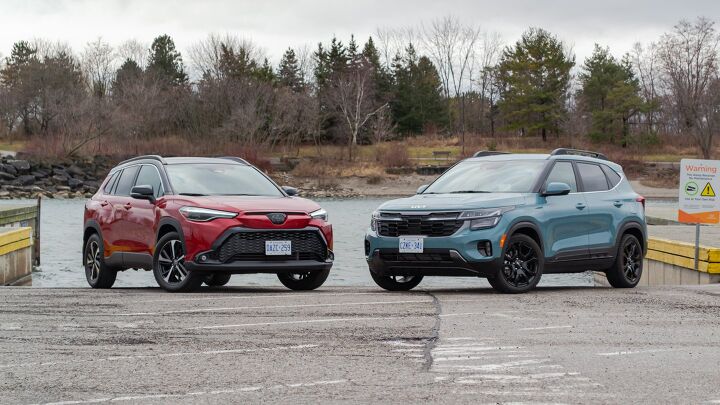
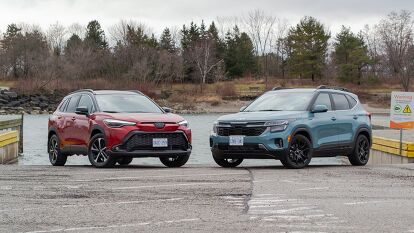






































































































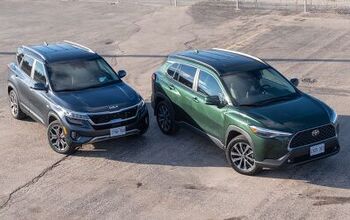
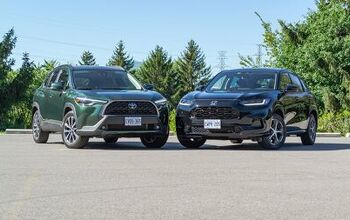
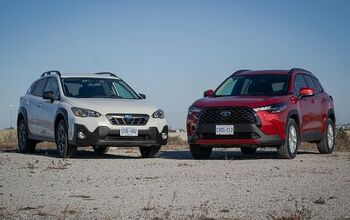
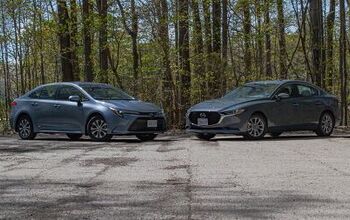











Comments
Join the conversation
just a note, The US trims of both XSE and SX do not come with the Heated Steering wheel.
in 23 KIA use to add them with the AWD package but seems to have dropped them in 24 likely to be more price competitive